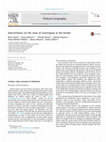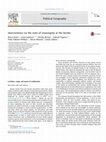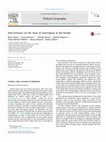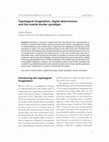Books by Gabriel Popescu
Papers by Gabriel Popescu

Building on previous insights that have decentered the understanding of borders in a simple, line... more Building on previous insights that have decentered the understanding of borders in a simple, linear manner, there have been recent calls for a paradigmatic change in understanding the role borders play in organizing and regulating contemporary social interaction in space. The main argument focuses on the shift of the role of borders from remote limits controlling access to state territories to central ordering devices at the core of societies both in symbolic and material terms. In this view, borders play vital roles in individuals’ lives, reaching deep into the fabric of societies to structure and regulate daily routines as well as long-term strategies. Several developments such as advances in digital technology, globalization-driven mobility imperatives, flow-related security demands, anda topological imagination of space, are converging to shape a new border paradigm that unsettles long established political and economic practices and rises essential questions about power relatio...

Political Geography, 2017
Recent events have put human encounters with state sovereignty at borders under intense scrutiny ... more Recent events have put human encounters with state sovereignty at borders under intense scrutiny from governments, media, and academics alike. Over 40,000 people died attempting to cross a border from 2006 to 2015 and a record 65 million people were displaced by conflict around the world in 2015 (http:// missingmigrants.iom.int/). These 40,000 þ deaths are not the direct results of wars where humans become the casualties of stateto-state conflicts or internal strife. Rather, they are a consequence of states expanding the reach of their security and detention practices to capture, intercede, or make intentionally perilous the movements of people in search of better opportunitiesdor often just basic safety and human dignitydfor themselves and their family. There are almost 70 border walls around the world, up from 15 in 1989 (Vallet, 2014), and these are just the most visible physical manifestations of what is much wider set of state practices to control movement such as deployments of more border guards, seaborne patrols, and investments in new technologies to monitor more comprehensively events within state space, at the edges of their territories, and beyond.
Journal of Borderlands Studies, 2014
... By GABRIEL POPESCU A Dissertation submitted to the Department of Geography in partial fulfill... more ... By GABRIEL POPESCU A Dissertation submitted to the Department of Geography in partial fulfillment of the requirements for the degree of Doctor of Philosophy Degree Awarded: Summer Semester, 2006 Copyright @ 2006 Gabriel Popescu All Rights Reserved Page 2. ...
Borderities and the Politics of Contemporary Mobile Borders, 2015

Recent events have put human encounters with state sovereignty at borders under intense scrutiny ... more Recent events have put human encounters with state sovereignty at borders under intense scrutiny from governments, media, and academics alike. Over 40,000 people died attempting to cross a border from 2006 to 2015 and a record 65 million people were displaced by conflict around the world in 2015 (http:// missingmigrants.iom.int/). These 40,000 þ deaths are not the direct results of wars where humans become the casualties of stateto-state conflicts or internal strife. Rather, they are a consequence of states expanding the reach of their security and detention practices to capture, intercede, or make intentionally perilous the movements of people in search of better opportunitiesdor often just basic safety and human dignitydfor themselves and their family. There are almost 70 border walls around the world, up from 15 in 198915 in (Vallet, 2014, and these are just the most visible physical manifestations of what is much wider set of state practices to control movement such as deployments of more border guards, seaborne patrols, and investments in new technologies to monitor more comprehensively events within state space, at the edges of their territories, and beyond.

Recent events have put human encounters with state sovereignty at borders under intense scrutiny ... more Recent events have put human encounters with state sovereignty at borders under intense scrutiny from governments, media, and academics alike. Over 40,000 people died attempting to cross a border from 2006 to 2015 and a record 65 million people were displaced by conflict around the world in 2015 (http:// missingmigrants.iom.int/). These 40,000 þ deaths are not the direct results of wars where humans become the casualties of stateto-state conflicts or internal strife. Rather, they are a consequence of states expanding the reach of their security and detention practices to capture, intercede, or make intentionally perilous the movements of people in search of better opportunitiesdor often just basic safety and human dignitydfor themselves and their family. There are almost 70 border walls around the world, up from 15 in 198915 in (Vallet, 2014, and these are just the most visible physical manifestations of what is much wider set of state practices to control movement such as deployments of more border guards, seaborne patrols, and investments in new technologies to monitor more comprehensively events within state space, at the edges of their territories, and beyond.

Building on previous insights that have decentered the understanding of borders in a simple, line... more Building on previous insights that have decentered the understanding of borders in a simple, linear manner, there have been recent calls for a paradigmatic change in understanding the role borders play in organizing and regulating contemporary social interaction in space. The main argument focuses on the shift of the role of borders from remote limits controlling access to state territories to central ordering devices at the core of societies both in symbolic and material terms. In this view, borders play vital roles in individuals' lives, reaching deep into the fabric of societies to structure and regulate daily routines as well as long-term strategies. Several developments such as advances in digital technology, globalization-driven mobility imperatives, flow-related security demands, and a topological imagination of space, are converging to shape a new border paradigm that unsettles long established political and economic practices and rises essential questions about power relationships in society in the twenty-first century.
The antiAtlas of Borders is an experimentation at the crossroads of research, art and practice. I... more The antiAtlas of Borders is an experimentation at the crossroads of research, art and practice. It was launched in 2011 at the Mediterranean Institute of Advanced Studies (Aix Marseille University), and has been co-produced by the Higher School of Art (Aix en Provence), PACTE laboratory (University of Grenoble-CNRS), Isabelle Arvers and La compagnie. Since then, it has gathered researchers (social and hard scientists), artists (web artists, tactical geographers, hackers, filmmakers, etc.) and professionals (customs, industry, military, etc.). The encounter of people coming from these different fields of knowledge and practice aims to create a radical shift of perspective in the way we apprehend both 21st century borders and the boundaries separating fields of knowledge, art and practice.
The antiAtlas of Borders is an experimentation at the crossroads of research, art and practice. I... more The antiAtlas of Borders is an experimentation at the crossroads of research, art and practice. It was launched in 2011 at the Mediterranean Institute of Advanced Studies (Aix Marseille University), and has been co-produced by the Higher School of Art (Aix en Provence), PACTE laboratory (University of Grenoble-CNRS), Isabelle Arvers and La compagnie. Since then, it has gathered researchers (social and hard scientists), artists (web artists, tactical geographers, hackers, filmmakers, etc.) and professionals (customs, industry, military, etc.). The encounter of people coming from these different fields of knowledge and practice aims to create a radical shift of perspective in the way we apprehend both 21st century borders and the boundaries separating fields of knowledge, art and practice.
Dialogues in Human Geography

Political Geography, Jan 1, 2008
Europe is currently experiencing an unprecedented process of reterritorialization in the context ... more Europe is currently experiencing an unprecedented process of reterritorialization in the context of European Union integration. Central to this process is the implementation of various cross-border cooperation schemes, commonly known as Euroregions, aimed at redefining fixed, border-induced Westphalian territoriality. The literature on Euroregions has primarily examined the reterritorialization of state power and institutions across borders, documenting the emergence of cross-border governance networks. However, the territorial underpinning of cross-border reterritorialization, as well as the process of territorial constitution of cross-border spaces has been less well explored. This paper examines cross-border reterritorialization from a geopolitical perspective informed by multi-scalar conceptualizations of political territoriality. Actors at supranational, national and local scales often follow territorial logics that are at odds with each other. Competing meanings of territory and territoriality interact to produce a geopolitics of Euroregions that shapes cross-border reterritorialization. The paper focuses on the Euroregions established at the current fringes of the EU, in the Romanian–Ukrainian–Moldovan borderlands.
EU enlargement, region building and sifting borders of …, Jan 1, 2006

Geopolitics, Jan 1, 2005
Recent years have witnessed increased interest in diasporas. In the current context of globalisat... more Recent years have witnessed increased interest in diasporas. In the current context of globalisation, diasporas have assumed greater prominence on the international stage. The link between diasporas and international politics, however, is relatively under-studied. The purpose of this study is to analyse the interconnections between diasporas and international politics from a geopolitical perspective. Specifically, I examine the linkages between the US-based Romanian diaspora and US foreign policy regarding Romania during the late 1990s when NATO expanded into Eastern Europe. The US-based Romanian diaspora attempted to influence the US political establishment to grant NATO membership to Romania during NATO’s 1997 expansion by reshaping the prevailing geopolitical discourse about Romania in order to move the borders of ‘sameness’ to include Romania as similar to rather than apart from ‘the West’.
Book chapters by Gabriel Popescu
Articles (Peer Reviewed) by Gabriel Popescu
Political Geography
Reece Jones, Corey Johnson, Wendy Brown, Gabriel Popescu, Polly Pallister-Wilkins, Alison Mounts ... more Reece Jones, Corey Johnson, Wendy Brown, Gabriel Popescu, Polly Pallister-Wilkins, Alison Mounts and Emily Gilbert
_________
Polly Pallister-Wilkins, 'Humanitarian borderwork: actors, spaces, categories'











Uploads
Books by Gabriel Popescu
Papers by Gabriel Popescu
Book chapters by Gabriel Popescu
Articles (Peer Reviewed) by Gabriel Popescu
_________
Polly Pallister-Wilkins, 'Humanitarian borderwork: actors, spaces, categories'
_________
Polly Pallister-Wilkins, 'Humanitarian borderwork: actors, spaces, categories'